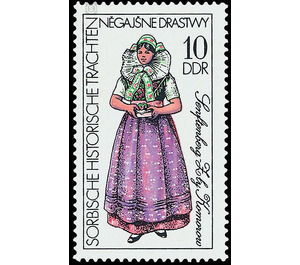Sorbian historical costumes - Germany / German Democratic Republic 1977 - 10 Pfennig
Theme: Art & Culture
| Country | Germany / German Democratic Republic |
| Issue Date | 1977 |
| Face Value | 10.00 |
| Color | multi-colored |
| Perforation | K 14 1/4 |
| Printing Type | Rotogravure 2 |
| Stamp Type | Postage stamp |
| Item Type | Stamp |
| Chronological Issue Number | 1952 |
| Chronological Chapter | GER-DDR |
| SID | 563417 |
| In 25 Wishlists | |
Sorbian Historical Costumes The Ministry of Posts and Telecommunications of the German Democratic Republic issues five multicolored special postage stamps with pictures of Sorbian historical women's costumes. Sorbian historical costumes Around the middle of the 19th century, all Sorbian girls and women of Lusatia wore folk costumes, while the men were already turning to fashionable clothing. Today, Sorbian folk costumes can only be found in four costal regions in the districts of Cottbus and Dresden, where they usually carry only older women. As early as 1968 festival costumes and 1972 dance costumes were displayed on special postage stamps from these areas. The present series is dedicated to the Sorbian-historical costumes, which, on a recent occasion in honor of the IX. Federal Congress of Domowina, the socialist national organization of the Sorbs, appears. These costumes, also known as truids, were created in the past for a variety of reasons. They have completely disappeared from the public today, and can only be found in chests or museums. Like the costumes that still live, they too bear witness to the wealth of ideas and creative power of the working people. 10 Pfennig value: costume from Senftenberg Officially referred to as Senftenberg-Spremberg costume, its range extends across the entire southern Lower Lusatia and reached with some foothills into the circles Forst and Guben inside. It depicts the women's festival dress, which was worn around 1880 for church attendance, weddings and other festive occasions. In this area, which until the mid-19th century had a purely agricultural character, it came in the last third of the 19th century to the digestion of lignite mines and thus conditioned the training and expansion of other industries. For the production of costumes, the basic colors were held in darker shades, in addition to the materials produced in the house work already used industrially produced fabrics of various kinds. Ornamented and artistically enriched individual pieces of the costume were through hole and tulle embroidery.


